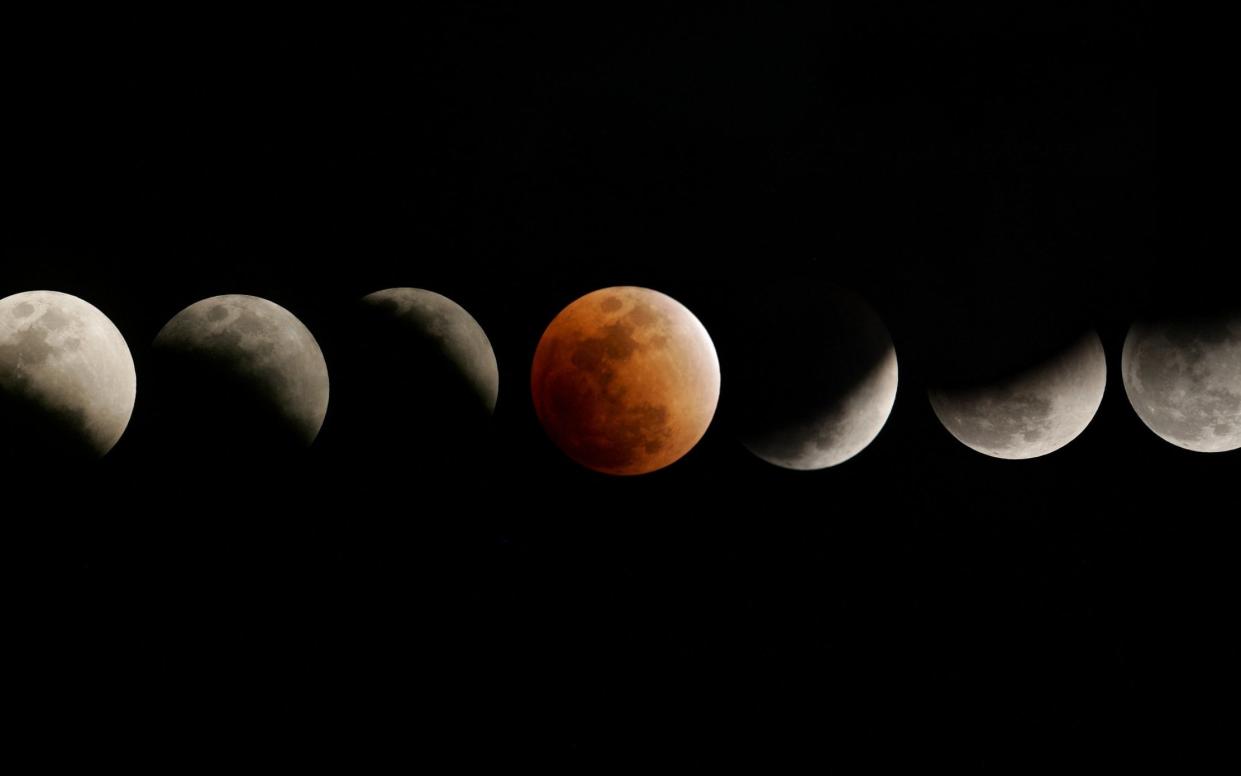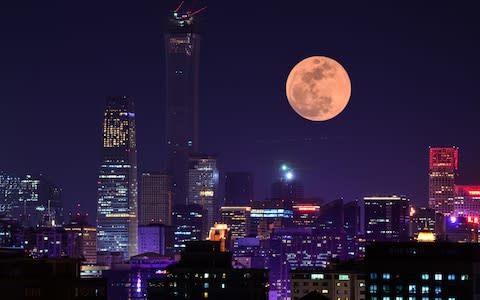Super blood wolf moon 2019: How to view Monday's total lunar eclipse in the UK

The moon's usual gleaming white hue will transform into a deep blood red on Monday in the last total lunar eclipse Britain is expected to experience for 10 years.
Most of North America, South America and areas of west and north Europe will be able to witness the event, while the remainder of Europe and Africa will see the end of the eclipse.
From the science behind the blood moon to whether we'll be able to see it in the UK, here is everything you need to know about the total lunar eclipse.
What is a total lunar eclipse and how does it occur?
A total lunar eclipse occurs when the Earth aligns between the sun and the moon, creating a shadow. The astronomical term to describe this process is syzygy, a Greek word which translates as "being paired together".
When a line forms, the darkest, central part of the Earth's shadow - known as the umbra - completely covers the moon and blocks sunlight directly reaching it.
While the umbra blocks light rays the moon remains visible in the sky and some of the sunlight passing through the Earth's atmosphere is refracted, giving it a dim glow during totality.
A total lunar eclipse can only form when a full moon is present; if the three entities were to lose their perfect alignment it would become a partial lunar eclipse.
Why does a total lunar eclipse not occur at every full moon?
Afull moon occurs every 29.5 days when Earth is directly aligned between the sun and the moon. The moon's orbital path around the Earth takes place at an angle of 5 degrees to Earth's orbital plane around the sun, otherwise known as the ecliptic.
Lunar eclipses can only take place when a full moon occurs around a lunar node, the point where the two orbital planes meets.
This means total lunar eclipses do not occur as frequently because the Earth's orbit around the sun is not in the same plane as the moon's orbit around the Earth.
What is a blood moon and is it different to a total lunar eclipse?
The moon's usual bright white hue may turn a burnt red-orange colour during a total lunar eclipse because sunlight passing through the Earth's atmosphere is bent towards it.
Colours in the spectrum with shorter wavelengths are blocked and filtered away while those with longer wavelengths such as red and orange are able to pass through.
The depth and darkness of the deep blood red varies during each eclipse, depending on how clear the atmosphere is at the time. Whenever this process of refraction happens, the moon is given the nickname 'blood moon'.

And this eclipse will also be a super moon?
Yes. A super moon - which is when a moon appears 30 per cent brighter and 14 per cent bigger to the naked eye - happens when a full moon is at the point in its orbit that brings it closest to Earth
Coincedentally this full moon - which is also a blood moon and also a total lunar eclipse - will be a supermoon, too.
Supermoon is not an astrological term though. It's scientific name is actually Perigee Full Moon, but supermoon is more catchy and is used by the media to describe our celestial neighbour when it gets up close.
Two more supermoons will occur this year: the second on February 19 and the third on March 21.
Some people are also calling this moon a wolf moon...
Yes, it's a wolf moon too - although this doesn't tell us anything about the state of the moon. Instead, the moniker 'Wolf Moon' was given to every January moon by Native Americans.
The early Native Americans didn't record time using months of the Julian or Gregorian calendar. Instead tribes gave each full moon a nickname to keep track of the seasons and lunar months.
Most of the names relate to an activity or an event that took place at the time in each location. However, it wasn't a uniform system and tribes tended to name and count moons differently. Some, for example, counted four seasons a year while others counted five. Others defined a year as 12 moons, while others said there were 13.
Colonial Americans adopted some of the moon names and applied them to their own calendar system which is why they're still in existence today, according to the Farmer’s Almanac.
The January moon was named Wolf Moon because villagers used to hear packs of wolves howling in hunger around this time of the year. Its other name is the Old Moon.
What time can you see the blood moon eclipse?
Observers in the British Isles who are willing to stay awake through the early hours of January 21 will be able to enjoy the total lunar eclipse.
The totality in the UK is expected to last 1 hour, 1 minute and 58 seconds. However the peak of the eclipse will be at 05:12 GMT, which means you'll have to get up early to be able to catch it.
At 02:36 GMT the moon will begin to darken as it enters the penumbral shadow and at 03:33 GMT the partial eclipse will begin, darkening further as it enters the Earth's umbra.
From approximately 04:41 GMT the moon will have completely entered the umbra shadow and the dark orange-red hue will appear in the sky, marking the start of the more visible total lunar eclipse.
The maximum eclipse, where the moon is closest to the centre of the umbra, will occur at 05:12 GMT, with the total eclipse ending at 05:43 GMT.
As the moon loses its blood red colou, it begins to enter the penumbral shadow again and the partial eclipse will end at 06:50 GMT.
While the moon continues to appear darker than usual, the penumbral eclipse will conclude at 07:48 GMT.

Blood moons and lunar eclipses of the past
Christopher Columbus, an Italian explorer, created fear in 1504 after he used knowledge of an upcoming blood moon to convince the Arawak Indians to help him while stranded in Jamaica.
He led them to believe their lack of support would anger God and result in a blood moon in the sky. When the moon began to "bleed", the Arawak Indians were fooled into giving Columbus and his crew food.
In more recent years, the total lunar eclipse of July 16, 2000 - which was seen in the Pacific Ocean, eastern Asia and Australia - was one of the longest to ever be recorded, lasting 1 hour 46 minutes.
The last lunar eclipse took place on July 27, 2018; and the totality spanned across 1 hour 43 minutes, marking the longest eclipse of the 21st century.
Blood moon myths and tales
From religious theories to modern day conspiracies, there are a range of myths and tales linked to the concept of a blood moon.
Some Christian conspiracists consider a blood moon to be an apocalyptic sign from the heavens while the Inca thought it represented an attack by a cosmic jaguar.
The Hupa, a Native American tribe from northern California, believed the moon had 20 wives and numerous pets including lions and snakes. When the moon didn't give them enough food to eat, they attacked it, consequently making it bleed.
The Batammaliba people in Togo and Benin, Africa, believe a lunar eclipse represents a fight between the sun and the moon, which humans must learn from in terms of their own arguments.
Other astronomical events in 2019
The Quadrantid meteor shower reached its maximum rate of activity on January 4, with shooting stars appearing in the sky each night up until January 6.
A conjunction of Venus and Jupiter will appear in the east sky before sunrise on January 22, showing the two bright planets 2.4 degrees from each other.
The Eta Aquarids Meteor Shower will be seen in dark locations after midnight on May 7, while Saturn will shine the brightest on July 9, this year, as reaches its closest approach to Earth.
Plus an annular solar eclipse will take place on December 26, starting in Saudi Arabia and concluding in the Pacific Ocean, with a ring of light appearing around the moon.

 Yahoo News
Yahoo News 
